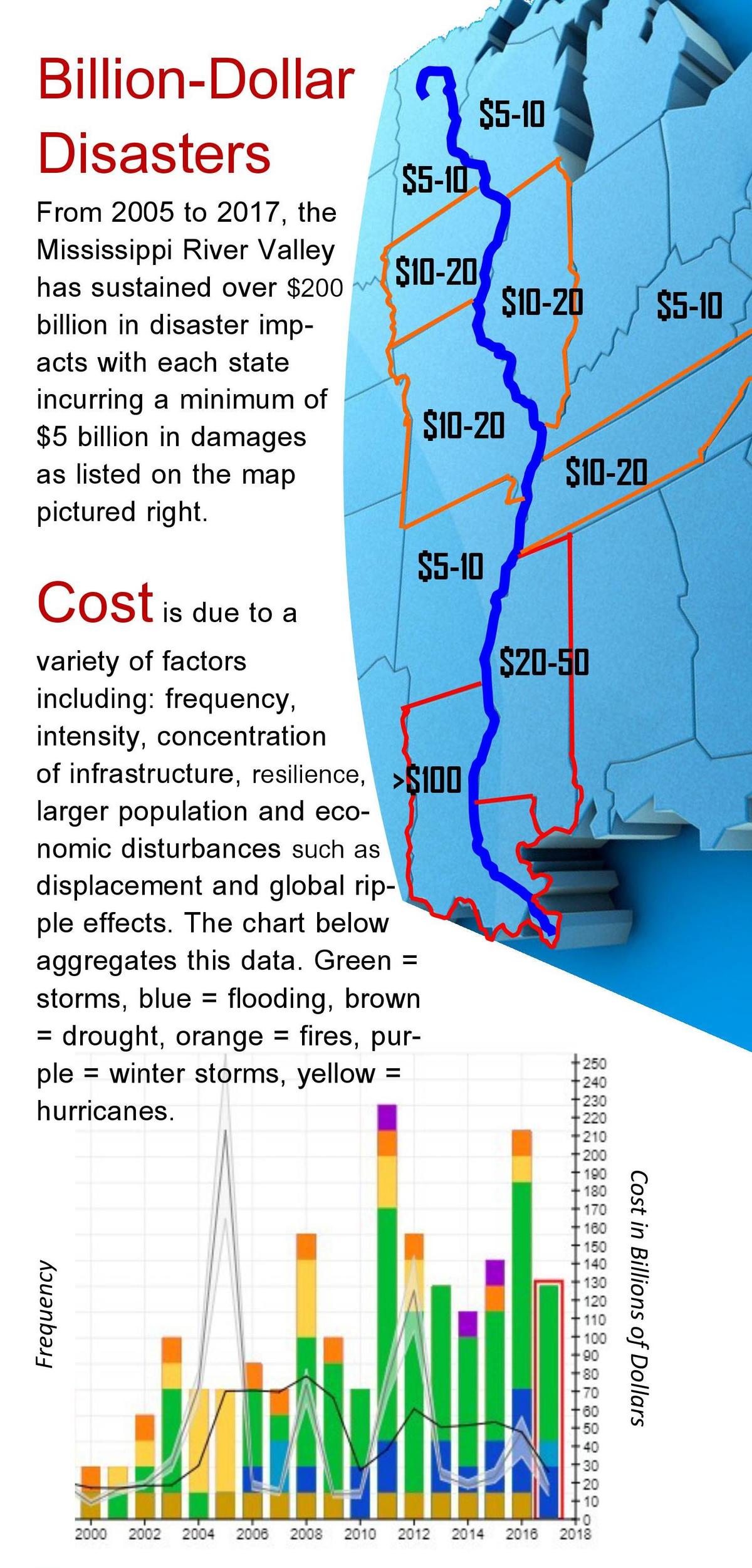

And in late August 2016, heavy rainfall and massive flooding caused $10 billion in damages around just the Baton Rouge area of Louisiana. In 2015-2016 alone, the Mississippi River Valley incurred over $13 billion in impact costs: an estimated $3 billion in damage from flooding that stretched from Grafton, IL to New Orleans, LA in the span of two months (December 2015 and most of January 2016).Furthermore, the 50-year magnitude drought in 2012 caused an estimated $31.5 billion in damages nationwide and affected at least 5 states bordering the river. Rain and flood related disasters along the Mississippi River have become persistent and systemic, incurring over $50 billion in costs since 2011.These temperature trends are explored more closely below. Increasing heat has costly implications for agricultural yields, labor productivity, public health, energy costs, and infrastructure throughout the corridor. Average temperatures are increasing in states along both the upper and lower Mississippi, although at varying rates.An attribution study published one month after heavy rainfall battered Louisiana in August 2016 found that climate change nearly doubled the chances for the heavy downpours that caused devastating flooding across the gulf state. Recent advances are making it easier to pin specific weather events to climate change.Since 2005, the Mississippi River Valley has sustained successive 100, 200, and 500-year rainfall events, a 50-year drought, Hurricane Katrina and Hurricane Isaac. The increased precipitation is interspersed with periods of no rain, creating a weather whiplash effect, which increases the risk of severe weather at both extremes. Heavier rains, combined with intensified snowpack melt on the headwaters, tributaries and mainstem of the Mississippi river, are increasing flood risk for basin communities.Recent storms along the Mississippi River have been supercharged by running over a warmer ocean and through an atmosphere made wetter by global warming. A warmer atmosphere holds more water vapor. The increasing frequency of heavy rain, both globally and in the Mississippi River Basin specifically, is among the clearest climate change impacts on weather.With the exception of tornadoes all of these hazards have well-documented links and are demonstrably aggravated by climate change. According to the 10 cities reporting to CDP in the Mississippi River basin in 2016 (Chicago IL, Cincinnati OH, Cleveland IL, Des Moines IA, Louisville KY, Minneapolis MN, New Orleans LA, Pittsburgh PA, St Louis MO, and Wisconsin Rapids WI), the surveyed cities reported varying susceptibility to the following risks: 60% face river flood as a hazard 50% face heat waves as a hazard 30% face severe wind 80% face flash/surface flood 40% face drought 20% face extreme winter conditions 40% face extreme hot days 20% face tornadoes 20% face vector-borne diseases.Assessing, Mitigating, and Communicating Flood Risk (Webinar), American Geosciences InstituteĢ017 webinar on flood risk assessment, mitigation, and communication efforts in the U.S.Geological Surveyĭata and information on past floods in the United States from 2011-2018. Shows the short-term chance of flooding for streams across the United States.

River Flooding Forecast (Interactive Map), National Weather Service.Overview of the National Flood Insurance Program, with resources for property owners, decision makers, insurance professionals, surveyors, and more National Flood Insurance Program (Webpage), FEMA.Map of rivers that are currently flooding across the United States. Current Flood Information (WaterWatch) (Interactive Map), U.S.
Mississippi river flood maps download#
FEMA's Flood Map Service Center (Interactive Map), FEMAįind and download a flood map for your area that shows long-term risk of flooding.Geological Survey (USGS) monitors real-time flooding conditions as they are occurring, while the National Weather Service (NWS) forecasts river flooding. These risk maps show the long-term risk of flooding occurring. There are different types of flood maps available.įlood Risk Maps: The Federal Emergency Management Agency (FEMA) studies flood risk and publishes maps for each community in the United States.


 0 kommentar(er)
0 kommentar(er)
